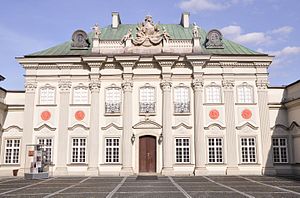Copper-Roof Palace
| Copper-Roof Palace Pałac Pod Blachą Template:Pl icon | |
|---|---|
 The Copper-Roof Palace or Tin-Roofed Palace " cour d'honneur. | |
 | |
| General information | |
| Architectural style | Rococo |
| Town or city | Warsaw |
| Country | Poland |
| Construction started | 1698 |
| Completed | 1701 |
| Demolished | 1944 |
| Client | Jerzy Dominik Lubomirski |
| Design and construction | |
| Architect(s) | Jakub Fontana |
The Copper-Roof Palace (Template:Lang-pl) is an 18th-century palace in Warsaw, Poland. It takes its unusual name (which is less precisely phrased in the Polish original) from its copper roof — a rarity in the first half of the 18th century. The palace since 1989 is a branch of the Royal Castle Museum.[1]
The palace is contiguous with Warsaw's Royal Castle, and down a slope from the Castle Square and Old Town. Beneath the palace, a 17th-century lodge still exists.[2]
History
Originally a patrician house of Wawrzyniec Reffus, it was built 1651-1656.[3] After 1657 destruction by the army of George II Rákóczi, it was completely remodeled in 1698-1701[2] for Jerzy Dominik Lubomirski.[3]
Lubomirski expanded the palace by building a southern wing, perpendicular to the rest of structure, and also expanded the western elevation. Shortly after its construction the palace became known as Palais Martin, after Lubomirski's grandson.[4] In 1720 the palace was rebuilt with an addition of a second northern wing. Additionally the interior was decorated with rococo paintings.[4] After 1777 the palace passed into ownership of Poland's last king, Stanisław August Poniatowski, who hired the architect Domenico Merlini to once again redesign the inside rooms of the palace and join the library wing of the Royal Castle to it.[4] The king then made a present of the redecorated place to his nephew Prince Józef Poniatowski[3] The younger Poniatowski was a successful commander in the 1794 Kościuszko Uprising, and later one of Napoleon Bonaparte's marshals. Under his ownership the palace became a center of Warsaw's high class social scene. When Warsaw became part of Kingdom of Prussia after the Third Partition of Poland the buildings became the headquarters for the Prussian Ministry of War.[4]
The Copper-Roof Palace was burned in 1944 and reconstructed, based on paintings of Bernardo Bellotto, between 1948-1949.[2]
Currently the palace is a museum, part of Royal Castle in Warsaw, hosting, inter alia, a permanent exhibition of oriental rugs.
Gallery
-
Southern facade
-
Eastern facade, St. Anne's Church on the left, Royal Castle on the right
-
Exhibition of oriental rugs
-
Prince Józef Poniatowski's bedroom
See also
References
- In-line:
- ^ "Remont i przebudowa pałacu Pod Blachą". www.zamek-krolewski.pl (in Polish). Retrieved 2009-03-23.
- ^ a b c "The "Pod Blachą" Palace". eGuide / Treasures of Warsaw on-line. Retrieved 2009-03-23.
- ^ a b c "Pałac pod Blachą". www.warszawa1939.pl (in Polish). Retrieved 2009-03-23.
- ^ a b c d ""Under the Metal Roof" Palace (Palac Pod Blacha)". www.wiezowce.waw.pl. Retrieved 2009-03-24.





